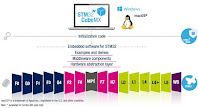Second step
So you got that blinking light, maybe you did some stuff with on board sensors or an external control. Nice!
By this time you must have stumbled across the 'library' thing.
Not structured. Not documented. No rules. Not standardized.
And as such a big cause of bugs and conceptual problems.(not only caused by yourself!)
Still you will need them: standing on the shoulders of others.
This alone took one month trial and error to get a working configuration going.
As I am using STM32 microcontrollers I use the HAL (hardware abstraction layer) libraries provided by STM.
More specifically: as these are generated by CubeMX
Next step is to get effluent in using CubeMX to generate the projects base code, then open/import this project in KEIL MdK to add your user code. Maybe get some knowledge about the build in debugging tools. These won't help you a lot in processing audio though, so don't waste to much time there..
Third step
Now start to understand what is needed to stream i2s data to your DAC. Dig through all those data sheets to learn and find details about the several i2s protocols and how to configure both DAC and MCU. Don't despair! Just familiarize yourself with the keywords and trust the work others have done for you (at least at first).
Apart from the different protocols (use Philips!), the most important concept is: clock signals. To make things more confusing different names are used:

MCK = CK = master clock
WS = LRCK = word select or LR clock
BCK = SCK = bit clock or serial clock
As audio freaks we do understand sample frequency and bit depth, and how they work out on the different clocks, don't we?
Now generate a sine-wave in code or use some table or whatever and see if you get a peep without cracks and or distortion. If you do consider yourselves lucky and talented. If not learn more about data formats! There is also some good youtube videos by Mutex if you get stuck.
Remember: this is bare metal coding so you have to control everything!
Again 1 more month of struggling: i2s audio data is a signed integer between -1 and 1 (times bithdepth -1) aka two's complement
You will have to control the data format all the time, casting stuff like:
txBuf =(uint16_t)data_out //filling send buffer with 'typecasted' correct data//
And also be aware of overflow! You can't just multiply or divide your data.
These are helpful:
data_out>>1 //data halved as in 6 dB down in volume//
And hey, here's interesting stuff: ever participated in the floating point versus fixed point debate of audio processing ?? hmmm..
next to part 3

